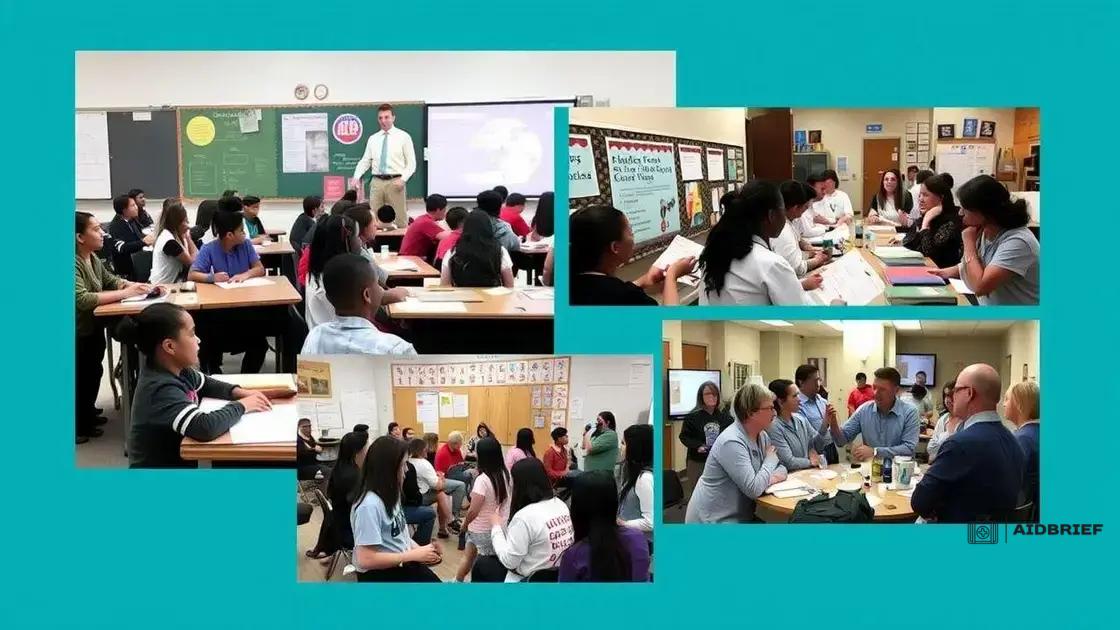Trump’s executive orders on education reform: What you need to know

Trump’s executive orders on education reform focus on promoting school choice, altering funding structures, and reducing federal oversight, significantly impacting public schools and charter systems across the United States.
Trump’s executive orders on education reform have stirred controversy and discussions across the nation. What do these orders really mean for schools and students? Let’s unravel the details.
Understanding Trump’s education reforms
Understanding Trump’s education reforms is essential for grasping the changes in education policy during his administration. These reforms aimed to reshape how education is delivered across the United States, impacting students and schools in significant ways.
Key areas of focus included issues such as school choice, education funding, and the role of federal oversight in education. By examining these aspects, we can understand the broader implications of Trump’s policies on the educational landscape.
School Choice Initiatives
One major aspect of Trump’s reforms was the push for school choice. This initiative encouraged families to opt for alternatives to public schools, such as charter schools and vouchers. These choices aimed to provide more opportunities for students to receive quality education in an environment that fits their needs.
- Expansion of charter schools across states.
- Funding for voucher programs to assist families.
- Support for homeschooling and online education options.
Changes in Education Funding
Another crucial element was the emphasis on education funding. The administration sought to redirect federal funds to support alternative education options and reduce reliance on traditional public school systems. This shift aimed to promote competition and choice among educational institutions.
This reallocating of funds has sparked debates about the long-term effects on public schools. Critics argue that diverting money could lead to less funding for public education, affecting students who remain in those systems.
Decrease in Federal Oversight
Additionally, Trump’s education reforms called for a decrease in federal oversight. The aim was to give states more control over their educational systems, allowing for tailored solutions that fit local needs. This approach resonated with many supporters who believed that local control would lead to better outcomes for students.
However, the reduction in federal oversight raised concerns about the potential for unequal education opportunities, especially in underfunded areas. It prompted discussions about the balance between state control and the need for equitable education.
Overall, Trump’s education reforms encompassed a range of initiatives aimed at transforming American education. Understanding these changes allows us to navigate the evolving landscape and their impact on students, educators, and communities.
Key executive orders and their implications
Trump’s administration introduced several executive orders that significantly influenced educational policies. These orders aimed to alter the structure and funding of education systems across the nation, which raised various discussions and implications.
Executive Order on School Choice
One of the most notable executive orders focused on promoting school choice. This directive encouraged families to select educational institutions that best suited their children’s needs, whether public, charter, or private schools. By facilitating access to different schooling options, this initiative aimed to enhance student performance and satisfaction.
- Increased funding for charter schools.
- Support for voucher programs that help families afford private education.
- Promotion of homeschooling initiatives.
Order to Reduce Administration Policies
Another critical order aimed at reducing federal regulations affecting education. This change sought to give states more control over their education systems. By cutting back on federal oversight, local governments could implement policies that align better with their communities.
While many supported this move as a way to increase local control, concerns were raised about the potential for reduced educational quality in under-resourced areas. This shift could lead to disparities in funding and resources across different districts.
Impact on Federal Funding
Trump’s executive orders also had implications for federal funding in education. By redirecting funds towards innovative educational programs, the administration emphasized a competitive model. Critics feared this approach could undermine public schools, diverting essential resources from students in traditional settings who might need them the most.
The discussions surrounding these orders reflect a broader conversation about the direction of education policy in the United States. Stakeholders continue to evaluate how these changes will affect student outcomes and the overall quality of education available.
Impact on public schools and charter systems

The impact on public schools and charter systems from Trump’s education reforms has been significant and multifaceted. As policies shifted, schools had to adapt to new guidelines and funding structures, creating both challenges and opportunities.
Effects on Public Schools
Public schools faced changes in funding due to redirection towards charter schools and other alternatives. This meant that resources were not always aligned with student needs, leading to budget constraints for some districts. In many cases, schools struggled to maintain programs that were vital for student success.
- Funding cuts can lead to larger class sizes.
- Reduced availability of extracurricular activities.
- Staff layoffs in underfunded districts.
Growth of Charter Schools
On the other hand, the growth of charter schools was notable. These schools often operate with more flexibility than traditional public schools, which allows them to try innovative teaching methods and curriculums. The demand for charter schools has increased as parents explore different options.
However, this growth has also raised questions about equity. As students migrate to these schools, traditional public schools may lose funding and resources, creating a disparity in quality across different districts. Some communities are left with under-resourced schools that struggle to meet the demands of their students.
Community Responses
Communities have reacted with concern over these changes. Parents and educators have expressed their fears regarding the long-term implications of redefining school structures. Advocates for traditional public education highlight the need for stable funding and equitable resources for all students.
To combat these issues, some districts are focusing on community engagement and exploring partnerships with local organizations to enhance educational offerings. It’s clear that the landscape of education is evolving, demanding continuous adaptation from both public schools and charter systems.
Responses from educators and policymakers
Responses from educators and policymakers regarding Trump’s education reforms have been diverse and passionate. Many educators have expressed both support and concern over the changes, highlighting the complexities involved in implementing new policies.
Support for Innovation
Some educators welcome the reforms, particularly the push for school choice and innovative teaching methods. They believe that these changes create opportunities for students to thrive in customized learning environments. Charter schools and voucher programs can enhance competition, leading to better educational outcomes.
- Opportunities for tailored education experiences.
- Increased parental involvement in education choices.
- Potential for innovative curricula and teaching styles.
Concerns About Equity
However, many educators are worried about the implications of these reforms on equity in education. They argue that redirecting funds away from traditional public schools can exacerbate existing inequalities. Underfunded schools often struggle to provide essential resources and support to students.
This concern is echoed by policymakers who emphasize the importance of equal access to quality education for all students. They advocate for maintaining essential funding levels to support public education and ensure no child is left behind.
Collaborative Efforts
In response to the changes, some educators and policymakers are engaging in collaborative efforts. By working together, they seek to find solutions that balance the benefits of reform with the need for equitable educational opportunities. These partnerships often include community input, allowing diverse perspectives to shape effective policies.
Ultimately, the responses from educators and policymakers reflect a broad spectrum of opinions. As discussions continue, the focus remains on how to best advocate for students while navigating the evolving educational landscape influenced by these reforms.
Future of education reforms under new leadership
The future of education reforms under new leadership is a topic of great interest and importance. With changes in administration, new policies and priorities are likely to shape the educational landscape in the coming years.
Shifts in Policy Direction
New leadership often brings a shift in policy direction, affecting key areas like funding, curriculum standards, and accountability measures. The incoming administration may focus on restoring funding to public schools or innovating education through technology and inclusive practices, addressing the needs of a diverse student population.
- Increased allocation of resources to underserved schools.
- Implementation of new technology in the classroom.
- Enhanced focus on mental health support for students.
Engagement with Stakeholders
As education reforms progress, engaging with stakeholders will be crucial. This includes collaboration with educators, parents, and community leaders to ensure that reforms reflect the needs and aspirations of students. Effective communication among these groups can lead to more balanced and comprehensive educational policies.
Moreover, addressing concerns about equity and access will likely take precedence. Leaders must emphasize policies that provide equal opportunities for all students, particularly those in disadvantaged communities. As reforms unfold, it will be important to monitor how changes affect various groups.
Potential Challenges Ahead
Despite the potential for positive change, challenges will also arise. Resistance to change can come from various sectors, including educators who may feel overwhelmed by new policies or parents concerned about their children’s futures. Navigating these challenges will require patience and a commitment to inclusion.
Ultimately, the future of education reforms will depend on how effectively new leaders can balance innovation with the essential needs of all students. As we look ahead, these decisions will play a vital role in shaping a brighter educational future for the next generation.
FAQ – Frequently Asked Questions about Trump’s Education Reforms
What are Trump’s main education reforms?
Trump’s education reforms focus on promoting school choice, increasing funding for charter schools, and reducing federal oversight of education.
How do these reforms impact public schools?
The reforms may redirect funding away from public schools, causing concerns about resource availability and educational equity.
What is the role of community involvement in education reforms?
Community involvement is crucial as it helps ensure that education policies reflect the needs and aspirations of students and families.
How might future leadership affect education policies?
New leadership can result in shifts in education priorities, potentially restoring funding to public schools and focusing more on equity in education.





